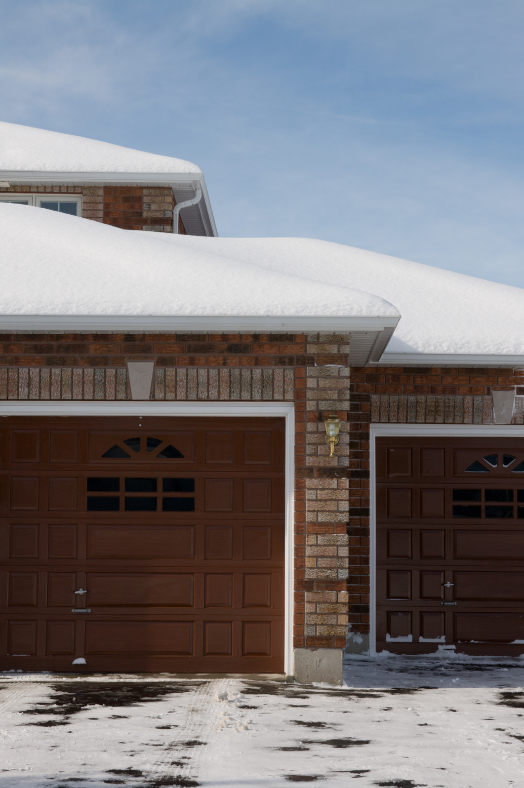As the leaves change colors and the crisp autumn air signals the arrival of winter, Midwest homeowners know that it’s time to start preparing for the colder months ahead. While you may be busy insulating your home and sealing windows, don’t forget about an often overlooked but crucial part of your property: your garage and garage door. As an expert garage door service company, we have some tips to help you ensure your garage is prepared for any climate you face.
Why Winterize Your Garage Door?
If you’re wondering how to keep your garage warm in the winter, you might be shocked at how much warm air escapes through your garage door, especially if it hasn’t been serviced on a regular basis. Winterizing your garage door is a smart investment that provides numerous benefits, including energy savings, protection for your vehicles and belongings, improved comfort, and increased safety.
Learning how to keep your garage warm in the winter also helps extend the lifespan of your garage door and reduces maintenance costs in the long run. Considering these advantages, taking the time to winterize your garage door is a wise decision for any homeowner, especially those in regions prone to harsh winter conditions like the Midwest. Check out our handy six-step guide below to learn how to winterize your garage door.
How To Winterize Your Garage Door in Six Easy Steps
Test The Balance
Testing the balance of your garage door is an essential maintenance task that helps ensure the door operates smoothly and safely. Having a garage door that balances correctly gives your opener the best chance of not breaking down during winter. If the door is not balanced correctly then it could lead to the opener failing in the middle of winter.
To test the balance, pull the release handle when the door is closed to disconnect it from the opener. Next, lift the door manually halfway. If it stays put, then the counterweight system is balanced correctly. If not, you will need to call a professional to rebalance your garage door.
Seal Any Gaps and Cracks
Most people open and close their doors multiple times a day. All of this movement wears on your doors, causing issues that allow cold air, snow, ice, and pests to enter. Seals should not allow gaps, bolts should be tight and cracked, and brittle weatherstripping needs to be replaced.
Begin by inspecting your garage door thoroughly. Look for any visible damage, cracks, or gaps in the door panels. Check the weatherstripping around the edges to make sure it’s intact and in good condition. If you find gaps or cracks in your garage door, they can let cold air, moisture, and even critters into your garage. Seal any holes with a high-quality silicone caulk or weatherstripping. Make sure the seals on the sides and bottom of the door are snug and in good shape. If they are worn or damaged, replace them promptly.
Lubricate Moving Parts
Winter weather can cause the metal components of your garage door to contract and become stiff. To prevent this, lubricate all moving parts of your garage door, including the springs, hinges, rollers, and tracks. Use a silicone-based lubricant, as it won’t freeze in cold temperatures.
Add Insulation
One of the most effective ways to winterize your garage door is to add insulation. There are several options available, including DIY insulation kits or hiring a professional to install insulation panels. Insulating your garage door can help maintain a more consistent temperature inside the garage, making it easier to heat if needed.
When you insulate your garage door, cut the insulation carefully so that it fits inside the door panels. Then, using an adhesive, secure each component. If your garage remains cold after the installation, you may want to consider replacing your existing door with a newer, more insulated type.
Check Your Garage Door Opener
Cold weather can affect your garage door opener’s performance. Inspect the opener for any signs of wear or damage. Ensure that the safety sensors are aligned correctly and functioning properly. Lubricate the opener’s chain or drive screw according to the manufacturer’s recommendations.
Examine the Rollers and Cables
Rollers need to be replaced every several years. Garage doors use strong, high-tension steel cables to lift and lower, and the cold makes these cables brittle. Inspect these cables to look for signs of wear, such as fraying.
Bonus Tip: Have Your Garage Door Serviced
Regular service is important to keep your garage door in good shape, and a tune-up before winter arrives is especially helpful. A professional garage door maintenance service will address issues before they become true problems.
Having it unexpectedly fail is inconvenient at any time, but it may be especially annoying in the cold. If you have questions about how to winterize your garage door or how to keep your garage warm in the winter, consult a professional. Fortunately, a garage door expert will be able to inspect your door, diagnose any problems, and apply lubrication as needed.
Be Ready for Winter!
Taking the time to learn how to winterize your garage door now can make a significant difference in your comfort and energy bills during the cold Midwest winters. Our garage door service allows for peace of mind. By inspecting, sealing, insulating, and maintaining your garage door, you’ll ensure that it performs optimally throughout the season. You’re likely researching how to winterize a garage door so you can do it yourself, but if you notice any significant issues, it’s best to contact a professional garage door technician for an inspection and repair. They have the expertise and equipment to diagnose and repair any problems safely. Don’t overlook this essential home maintenance task, as it can contribute to a warmer and more energy-efficient home. Stay warm, stay cozy, and enjoy the winter season to the fullest!

